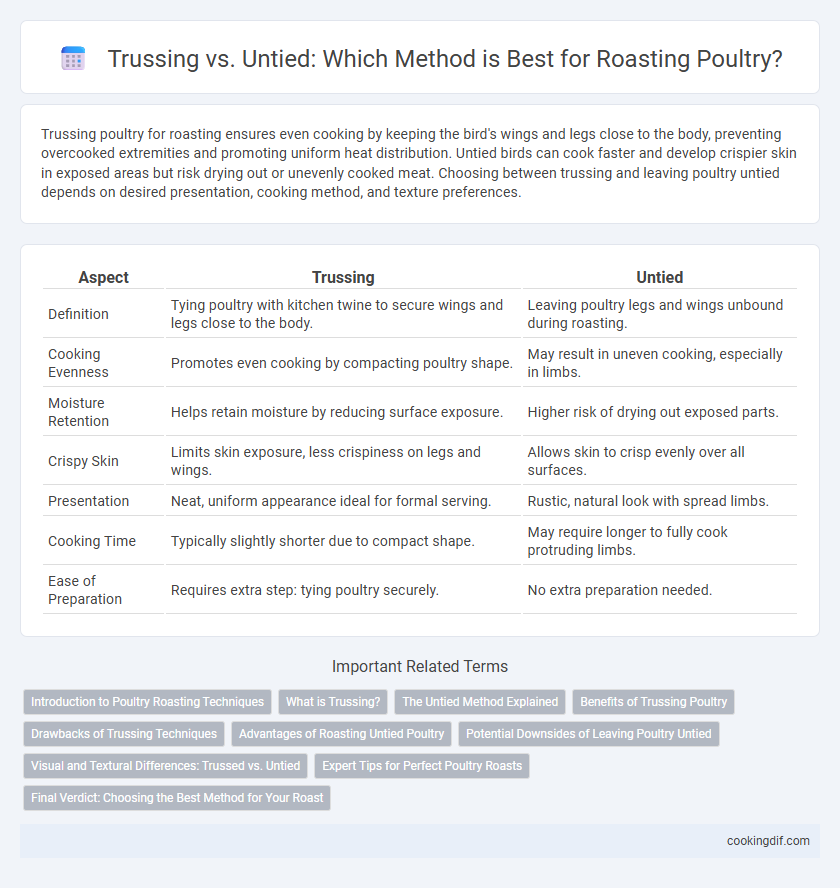Trussing poultry for roasting ensures even cooking by keeping the bird's wings and legs close to the body, preventing overcooked extremities and promoting uniform heat distribution. Untied birds can cook faster and develop crispier skin in exposed areas but risk drying out or unevenly cooked meat. Choosing between trussing and leaving poultry untied depends on desired presentation, cooking method, and texture preferences.
Table of Comparison
| Aspect | Trussing | Untied |
|---|---|---|
| Definition | Tying poultry with kitchen twine to secure wings and legs close to the body. | Leaving poultry legs and wings unbound during roasting. |
| Cooking Evenness | Promotes even cooking by compacting poultry shape. | May result in uneven cooking, especially in limbs. |
| Moisture Retention | Helps retain moisture by reducing surface exposure. | Higher risk of drying out exposed parts. |
| Crispy Skin | Limits skin exposure, less crispiness on legs and wings. | Allows skin to crisp evenly over all surfaces. |
| Presentation | Neat, uniform appearance ideal for formal serving. | Rustic, natural look with spread limbs. |
| Cooking Time | Typically slightly shorter due to compact shape. | May require longer to fully cook protruding limbs. |
| Ease of Preparation | Requires extra step: tying poultry securely. | No extra preparation needed. |
Introduction to Poultry Roasting Techniques
Trussing poultry ensures even cooking by securely tying the legs and wings close to the body, which helps retain moisture and maintain shape during roasting. Untied poultry allows for more crispy skin exposure, especially on the wings and legs, but can result in uneven cooking or dryer meat in extremities. Choosing between trussing and leaving the bird untied depends on desired texture, presentation, and cooking method preferences.
What is Trussing?
Trussing is the culinary technique of tying poultry, such as chicken or turkey, with kitchen twine to secure its legs and wings close to the body. This method helps the bird cook evenly by maintaining a compact shape, preventing overcooking of extremities, and promoting juicy, tender meat. Proper trussing improves presentation and ensures consistent roasting results, enhancing flavor and texture.
The Untied Method Explained
The untied method for poultry roast involves cooking the bird without securing its legs and wings, allowing for more even heat circulation and crispier skin. This technique can enhance natural moisture retention by preventing constriction, resulting in juicier meat and a more rustic appearance. Chefs often prefer the untied approach to showcase the bird's natural shape while achieving a flavorful, golden-brown exterior.
Benefits of Trussing Poultry
Trussing poultry ensures even cooking by securing wings and legs close to the body, reducing the risk of overcooked extremities and undercooked thick areas. It promotes a compact shape that retains moisture and enhances presentation with an attractive, uniform roast. Proper trussing also helps maintain stuffing inside the cavity, preventing spills and improving overall flavor infusion.
Drawbacks of Trussing Techniques
Trussing poultry can restrict heat circulation, leading to uneven cooking and potentially undercooked areas. The technique may also cause skin tearing or compression, reducing crispiness and overall presentation quality. Improper trussing increases the risk of foodborne illness by creating pockets where bacteria can thrive if the bird isn't cooked thoroughly.
Advantages of Roasting Untied Poultry
Roasting untied poultry allows for more even heat circulation, resulting in crispier skin and enhanced flavor development. The natural shape of the bird helps juices distribute better, producing a moist and tender interior without the risk of uneven cooking caused by tight trussing. This method also saves preparation time and enables easier seasoning of the cavity, enhancing overall taste and texture.
Potential Downsides of Leaving Poultry Untied
Leaving poultry untied during roasting can cause uneven cooking, as the wings and legs spread out, increasing exposure and risking overcooked or dried-out extremities. Untied birds may lose their shape, affecting presentation and limiting even browning on the surface. Additionally, stuffing can fall out more easily, reducing flavor infusion and moisture retention inside the cavity.
Visual and Textural Differences: Trussed vs. Untied
Trussing poultry tightly secures the wings and legs, creating a compact, uniform shape that promotes even browning and an attractive, symmetrical presentation. Untied poultry allows the limbs to spread out during roasting, resulting in uneven cooking with crispier skin on exposed areas and potentially drier meat where the bird folds. Texturally, trussed poultry often remains juicier with tender meat due to consistent heat distribution, while untied poultry boasts varied textures, combining crispy extremities with softer, juicier interior parts.
Expert Tips for Perfect Poultry Roasts
Trussing poultry ensures even cooking by securing the wings and legs close to the body, preventing overcooking and maintaining shape for an attractive presentation. Untied birds allow heat to circulate more freely, resulting in crispier skin but require careful monitoring to avoid uneven doneness. Experts recommend trussing for larger birds to retain moisture and tenderness, while smaller birds benefit from being untied to maximize skin crispiness.
Final Verdict: Choosing the Best Method for Your Roast
Trussing poultry ensures even cooking and maintains the bird's shape, resulting in a tender and visually appealing roast with crisp skin. Untied roasting allows better heat circulation around the bird, promoting faster cooking but may cause uneven browning and less moisture retention. For the best roast, choose trussing when presentation and juiciness are priorities, while leaving poultry untied suits faster cooking and rustic, casual meals.
Trussing vs Untied for poultry roast Infographic

 cookingdif.com
cookingdif.com